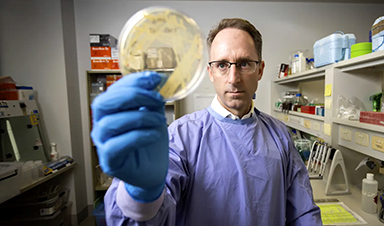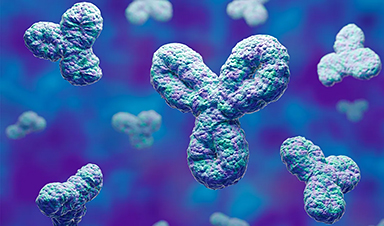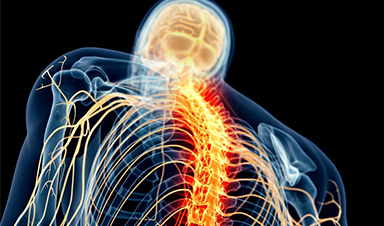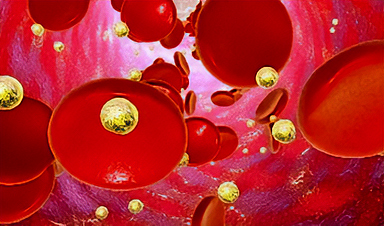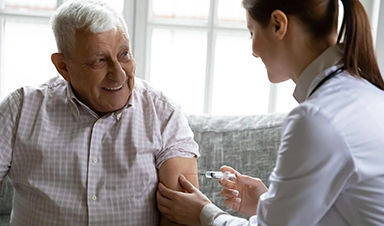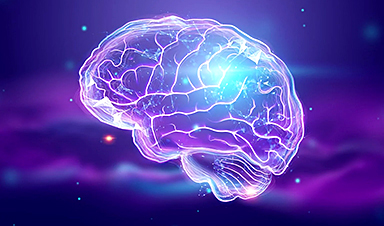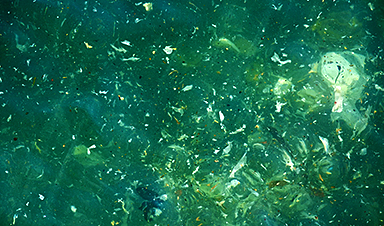A treatment first used more than a century ago, that uses bacteria-killing viruses, is making a comeback in Australia and doctors hope it will help counter a growing crisis of antibiotic-resistant superbugs.
The Alfred hospital in Melbourne has become the first health service in Victoria to begin using the pioneering phage therapy, which involves utilising harmless viruses – known as bacteriophages – to kill germs in cases where traditional antibiotics have failed.
Professor Anton Peleg, head of infectious diseases at The Alfred, said phage therapy was being used for an increasing number of patients battling potentially deadly superbugs, on compassionate grounds.
“They are patients with severe bacterial infections that are either life-threatening, or limb threatening, or function threatening, where they don’t have any other options left,” Peleg said. “It is a salvage treatment pathway.”
However, global interest in the therapy was reawakened recently by the rise of superbugs that have developed a resistance to antibiotics.
“We desperately need novel approaches to attack superbugs, approaches that are different to existing traditional antibiotics,” Peleg said.
Increasingly, phages are now being seen by some scientists as a potential complement or even an alternative to antibiotics, the overuse of which has contributed to increasing bacterial resistance and the advent of the superbug.
The Alfred’s phage therapy program began at the end of last year in partnership with Monash University’s Centre to Impact AMR (antimicrobial resistance), and has already been used to treat people who are severely ill with antibiotic-resistant infections, including patients with cystic fibrosis, who have endured years of chronic lung infections.
Others being referred to the program include those with drug-resistant prosthetic joint or limb infections and severe burn wounds.
“We recently received another referral for a woman with a recurrent urinary tract infection with terribly resistant bacteria,” Peleg said.
According to the World Health Organisation, antimicrobial resistance is a rising threat to global health, jeopardising decades of medical progress and transforming common infections into deadly ones. A UN report suggests yearly deaths from drug-resistant diseases could rise from 700,000 to 10 million in 30 years if no action is taken.
Phage therapy, which is most commonly provided intravenously, can be required for several months. Peleg said patients at The Alfred undergoing the treatment were monitored closely to evaluate the activity of the phage in their bodies.
Peleg said the treatment depended on accurate diagnosis of the bacterial strain causing infection and the phage required to fight it. With billions of different bacteria killing viruses in our natural environment – found in river systems, soil and sewage – sourcing the appropriate phage can be difficult.
To speed up this process, Peleg and his team spent the past four years collecting the most common bacteria that have caused infections at The Alfred. Among them is Staphylococcus aureus bacteria, also known as golden staph and pseudomonas.
The hospital also has an onsite translational phage lab, where staff scour environmental sources, identify phages, then test their activity with a combination of antibiotics. The phages are then produced and packaged into vials by an expert team at Monash University.
“We’ve been storing the most common bacteria causing infection at The Alfred and are looking for phage that have killing activity against those bacteria to develop a phage biobank,” Peleg said. “This allows us to have a cocktail of multiple phages, prepared to use for future patients with bacterial infections.”
He said phage therapy was gaining traction in Australia, with teams in Melbourne and Western Australia treating their first patients recently.
But Iredell said a lack of robust data and large-scale clinical studies had hindered advancements and understanding. In Australia, the treatment is still deemed experimental and is awaiting approval by the Therapeutics Goods Administration.
“It’s our job to be sceptical, and we have to make sure this is safe, but all the data suggests so far that it is safe when it is used properly and the phage is made properly,” Iredell said.
Australians wanting the treatment must fit strict eligibility criteria, including being referred to an infectious disease specialist, who can certify they are already using the appropriate treatment and more was needed.
Iredell and Peleg are part of a group of doctors working to develop a regulatory framework to use phage therapy nationally in the hope it will pave the way for big clinical studies in Australian hospitals.
Experimental cases overseas, including two patients in the US who recovered from intractable infections after being treated with genetically engineered bacteria-killing viruses.
In 2019, a teenager in the UK also made a remarkable recovery after being among the first patients in the world to be given a genetically engineered virus to treat a drug-resistant infection.
“All of us in the phage community often joke for every bacterial problem there is a phage solution because they’re the natural predators and since before humans evolved,” Iredell said. “Antibiotic resistant infections are one of the greatest risks to modern health infrastructure, and we need to act now.”
News
Specially engineered antibody delivers RNA therapy to treatment-resistant tumors
Elias Quijano, PhD; Diana Martinez-Saucedo, PhD; Zaira Ianniello, PhD; and Natasha Pinto-Medici, PhD, there are 25 other contributors, most from Yale's Department of Therapeutic Radiology and from the departments of genetics, molecular biophysics and [...]
Vaccinated women face fewer cervical cancer risks
New data from Denmark shows the HPV vaccine’s powerful long-term impact, while also revealing why cervical cancer screening is still essential. A Danish study published in the journal Eurosurveillance reports that women who received the human [...]
3D-printed implant offers a potential new route to repair spinal cord injuries
A research team at RCSI University of Medicine and Health Sciences has developed a 3-D printed implant to deliver electrical stimulation to injured areas of the spinal cord, offering a potential new route to [...]
Nanocrystals Carrying Radioisotopes Offer New Hope for Cancer Treatment
The Science Scientists have developed tiny nanocrystal particles made up of isotopes of the elements lanthanum, vanadium, and oxygen for use in treating cancer. These crystals are smaller than many microbes and can carry isotopes of [...]
New Once-a-Week Shot Promises Life-Changing Relief for Parkinson’s Patients
A once-a-week shot from Australian scientists could spare people with Parkinson’s the grind of taking pills several times a day. The tiny, biodegradable gel sits under the skin and releases steady doses of two [...]
Weekly injectable drug offers hope for Parkinson’s patients
A new weekly injectable drug could transform the lives of more than eight million people living with Parkinson's disease, potentially replacing the need for multiple daily tablets. Scientists from the University of South Australia [...]
Most Plastic in the Ocean Is Invisible—And Deadly
Nanoplastics—particles smaller than a human hair—can pass through cell walls and enter the food web. New research suggest 27 million metric tons of nanoplastics are spread across just the top layer of the North [...]
Repurposed drugs could calm the immune system’s response to nanomedicine
An international study led by researchers at the University of Colorado Anschutz Medical Campus has identified a promising strategy to enhance the safety of nanomedicines, advanced therapies often used in cancer and vaccine treatments, [...]
Nano-Enhanced Hydrogel Strategies for Cartilage Repair
A recent article in Engineering describes the development of a protein-based nanocomposite hydrogel designed to deliver two therapeutic agents—dexamethasone (Dex) and kartogenin (KGN)—to support cartilage repair. The hydrogel is engineered to modulate immune responses and promote [...]
New Cancer Drug Blocks Tumors Without Debilitating Side Effects
A new drug targets RAS-PI3Kα pathways without harmful side effects. It was developed using high-performance computing and AI. A new cancer drug candidate, developed through a collaboration between Lawrence Livermore National Laboratory (LLNL), BridgeBio Oncology [...]
Scientists Are Pretty Close to Replicating the First Thing That Ever Lived
For 400 million years, a leading hypothesis claims, Earth was an “RNA World,” meaning that life must’ve first replicated from RNA before the arrival of proteins and DNA. Unfortunately, scientists have failed to find [...]
Why ‘Peniaphobia’ Is Exploding Among Young People (And Why We Should Be Concerned)
An insidious illness is taking hold among a growing proportion of young people. Little known to the general public, peniaphobia—the fear of becoming poor—is gaining ground among teens and young adults. Discover the causes [...]
Team finds flawed data in recent study relevant to coronavirus antiviral development
The COVID pandemic illustrated how urgently we need antiviral medications capable of treating coronavirus infections. To aid this effort, researchers quickly homed in on part of SARS-CoV-2's molecular structure known as the NiRAN domain—an [...]
Drug-Coated Neural Implants Reduce Immune Rejection
Summary: A new study shows that coating neural prosthetic implants with the anti-inflammatory drug dexamethasone helps reduce the body’s immune response and scar tissue formation. This strategy enhances the long-term performance and stability of electrodes [...]
Scientists discover cancer-fighting bacteria that ‘soak up’ forever chemicals in the body
A family of healthy bacteria may help 'soak up' toxic forever chemicals in the body, warding off their cancerous effects. Forever chemicals, also known as PFAS (per- and polyfluoroalkyl substances), are toxic chemicals that [...]
Johns Hopkins Researchers Uncover a New Way To Kill Cancer Cells
A new study reveals that blocking ribosomal RNA production rewires cancer cell behavior and could help treat genetically unstable tumors. Researchers at the Johns Hopkins Kimmel Cancer Center and the Department of Radiation Oncology and Molecular [...]
